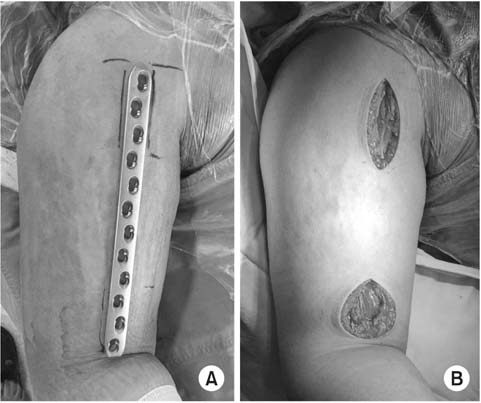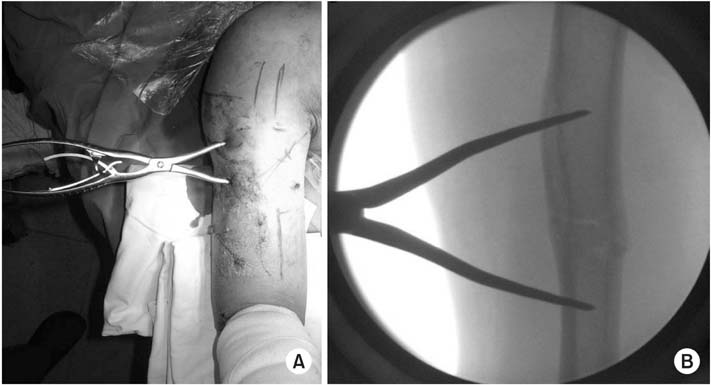J Korean Fract Soc.
2017 Jul;30(3):124-130. 10.12671/jkfs.2017.30.3.124.
Minimal Invasive Plate Osteosynthesis versus Conventional Open Plating in Simple Humeral Shaft Fracture (AO Type A, B1, B2)
- Affiliations
-
- 1Department of Orthopaedic Surgery, Chosun University School of Medicine, Gwangju, Korea. leekci@chosun.ac.kr
- KMID: 2424120
- DOI: http://doi.org/10.12671/jkfs.2017.30.3.124
Abstract
- PURPOSE
The purpose of this study is to evaluate the efficacy of minimally invasive plate osteosynthesis (MIPO) by comparing the results between open plating and MIPO conducted by simple humeral shaft fractures.
MATERIALS AND METHODS
From September 2010 to February 2015, we evaluated humeral shaft fractures that 26 cases underwent MIPO and 41 cases underwent open plate fixation (OPEN). Operation time, amount of blood loss, and radiative exposure time were examined. Radiographically, bone union time and angulation were compared. At last, UCLA shoulder score and MEPI were used to compare the clinical results of shoulder and elbow and complications were examined.
RESULTS
The average operation time 82±23 minutes in MIPO, 119±20 minutes in OPEN (p=0.007) and amount of bleeding 238±67 ml in MIPO, 303±48 ml in OPEN (p=0.003), radiation exposure time 201±85 seconds in MIPO, 20±5 seconds in OPEN (p=0.000) were statistically significant. Bone union time and angulations, clinical results were not statistically significant. In Complication, iatrogenic radial nerve paralysis occurred 2 cases, nonunion occurred 1 case in MIPO. Nonunion and soft tissue infection occurred 2 cases each in OPEN.
CONCLUSION
MIPO in simple humeral shaft fractures gave us radiologically and clinically satisfactory results, and may be useful by understanding the anatomical knowledge and using appropriate implants and skills.
MeSH Terms
Figure
Reference
-
1. Bae SW, Kim WJ, Song BY, Choi NH, Lee JH. Postoperative functional assessments in adult humerus shaft fractures-comparison among plates and screws, intramedullary nail and external fixator-. J Korean Soc Fract. 2001; 14:228–235.
Article2. Bhandari M, Devereaux PJ, McKee MD, Schemitsch EH. Compression plating versus intramedullary nailing of humeral shaft fractures: a meta-analysis. Acta Orthop. 2006; 77:279–284.
Article3. An Z, He X, Jiang C, Zhang C. Treatment of middle third humeral shaft fractures: minimal invasive plate osteosynthesis versus expandable nailing. Eur J Orthop Surg Traumatol. 2012; 22:193–199.
Article4. Changulani M, Jain UK, Keswani T. Comparison of the use of the humerus intramedullary nail and dynamic compression plate for the management of diaphyseal fractures of the humerus. A randomised controlled study. Int Orthop. 2007; 31:391–395.
Article5. Chiu FY, Chen CM, Lin CF, Lo WH, Huang YL, Chen TH. Closed humeral shaft fractures: a prospective evaluation of surgical treatment. J Trauma. 1997; 43:947–951.6. Dabezies EJ, Banta CJ 2nd, Murphy CP, d'Ambrosia RD. Plate fixation of the humeral shaft for acute fractures, with and without radial nerve injuries. J Orthop Trauma. 1992; 6:10–13.7. Bell MJ, Beauchamp CG, Kellam JK, McMurtry RY. The results of plating humeral shaft fractures in patients with multiple injuries. The Sunnybrook experience. J Bone Joint Surg Br. 1985; 67:293–296.
Article8. McCormack RG, Brien D, Buckley RE, McKee MD, Powell J, Schemitsch EH. Fixation of fractures of the shaft of the humerus by dynamic compression plate or intramedullary nail. A prospective, randomised trial. J Bone Joint Surg Br. 2000; 82:336–339.9. Apivatthakakul T, Arpornchayanon O, Bavornratanavech S. Minimally invasive plate osteosynthesis (MIPO) of the humeral shaft fracture. Is it possible? A cadaveric study and preliminary report. Injury. 2005; 36:530–538.
Article10. Jiang R, Luo CF, Zeng BF, Mei GH. Minimally invasive plating for complex humeral shaft fractures. Arch Orthop Trauma Surg. 2007; 127:531–535.
Article11. Babst R, Bavonratanavech S, Pesantez R. Minimally invasive plate osteosynthesis. Switzerland: AO Foundati;2012. p. 86–90.12. Smith MV, Calfee RP, Baumgarten KM, Brophy RH, Wright RW. Upper extremity-specific measures of disability and outcomes in orthopaedic surgery. J Bone Joint Surg Am. 2012; 94:277–285.
Article13. Turchin DC, Beaton DE, Richards RR. Validity of observer-based aggregate scoring systems as descriptors of elbow pain, function, and disability. J Bone Joint Surg Am. 1998; 80:154–162.
Article14. Vander Griend R, Tomasin J, Ward EF. Open reduction and internal fixation of humeral shaft fractures. Results using AO plating techniques. J Bone Joint Surg Am. 1986; 68:430–433.
Article15. Apivatthakakul T, Phornphutkul C, Laohapoonrungsee A, Sirirungruangsarn Y. Less invasive plate osteosynthesis in humeral shaft fractures. Oper Orthop Traumatol. 2009; 21:602–613.
Article16. Ji F, Tong D, Tang H, et al. Minimally invasive percutaneous plate osteosynthesis (MIPPO) technique applied in the treatment of humeral shaft distal fractures through a lateral approach. Int Orthop. 2009; 33:543–547.
Article17. Livani B, Belangero WD. Bridging plate osteosynthesis of humeral shaft fractures. Injury. 2004; 35:587–595.
Article18. Zhiquan A, Bingfang Z, Yeming W, Chi Z, Peiyan H. Minimally invasive plating osteosynthesis (MIPO) of middle and distal third humeral shaft fractures. J Orthop Trauma. 2007; 21:628–633.
Article19. Oh CW, Byun YS, Oh JK, et al. Plating of humeral shaft fractures: comparison of standard conventional plating versus minimally invasive plating. Orthop Traumatol Surg Res. 2012; 98:54–60.
Article20. Lee HJ, Oh CW, Kim DH, Park KH. Minimally invasive anterior plating of humeral shaft fractures. J Korean Fract Soc. 2011; 24:341–346.
Article21. Farragos AF, Schemitsch EH, McKee MD. Complications of intramedullary nailing for fractures of the humeral shaft: a review. J Orthop Trauma. 1999; 13:258–267.
Article22. An Z, Zeng B, He X, Chen Q, Hu S. Plating osteosynthesis of mid-distal humeral shaft fractures: minimally invasive versus conventional open reduction technique. Int Orthop. 2010; 34:131–135.23. Livani B, Belangero WD, Castro de. Fractures of the distal third of the humerus with palsy of the radial nerve: management using minimally-invasive percutaneous plate osteosynthesis. J Bone Joint Surg Br. 2006; 88:1625–1628.24. Kobayashi M, Watanabe Y, Matsushita T. Early full range of shoulder and elbow motion is possible after minimally invasive plate osteosynthesis for humeral shaft fractures. J Orthop Trauma. 2010; 24:212–216.
Article
- Full Text Links
- Actions
-
Cited
- CITED
-
- Close
- Share
- Similar articles
-
- Minimally Invasive Anterior Plating of Humeral Shaft Fractures
- Operative Treatment of Humerus Shaft Fracture: Conventional Open Plating or Minimally Invasive Plate Osteosynthesis
- Minimal Open Reduction and Interlocking IM Nailing of Comminuted Humeral Shaft Fracture: Comparison between Plate Internal Fixation
- Helical Plating for Fractures of the Proximal Humeral Shaft
- Surgical Treatment of Clavicle Midshaft Fractures Using a Locking Compression Plate: Conventional Open Reduction and Plating with Internal Fixation versus Minimal Invasive Plate Osteosynthesis




